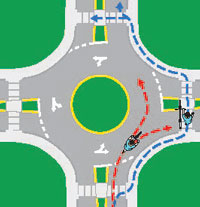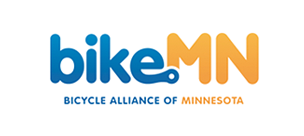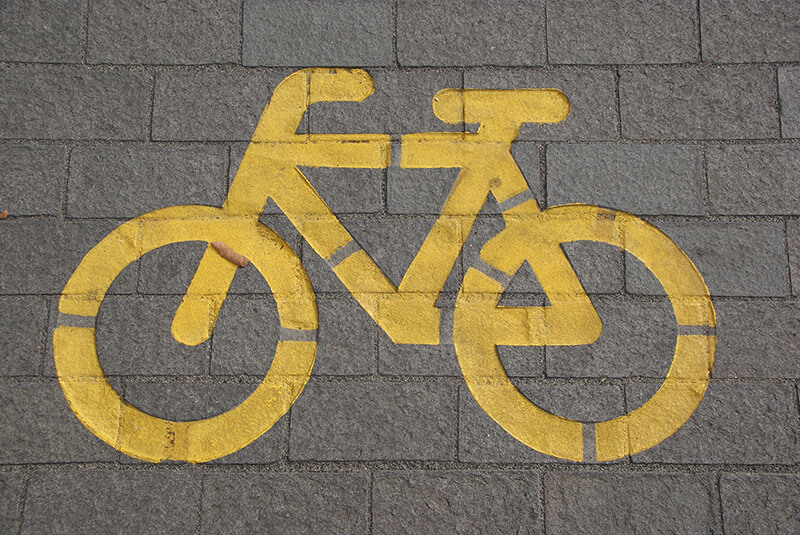Bike lanes and bike-related road markings continue to spring up across the state. Each city must comply with Minnesota MUTCD (Manual on Uniform Traffic Control Devices) standards for facilities. However, not all communities will choose to use all of these markings in signs.
Quick Guide
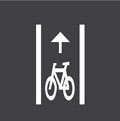
Bike lanes with solid lines
These are for bikes only. Drivers should not cross into them unless you’re turning or parking, and be sure to yield to bikes first.
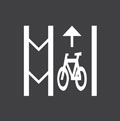
Buffered Bike Lanes
A buffered bike lane is restricted to bicycle traffic, except in instances when motorists need to turn, enter, or leave the roadway.
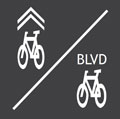
Bike symbols
A bike symbol that is not in a bike lane highlights a designated bike route. Drivers can drive on them as normal, but the bike symbols are a reminder to expect and look for bikes.
Bike-Related Road Markings
Bike Lanes
A bicycle lane is a portion of a street adjacent to the travel lane that is reserved for bicyclists. Bicycle lanes are typically on the right side of the road and are designated with pavement markings with arrows that direct bicyclists in the direction of travel. Bike lane signs are typically also placed alongside the road. A bicyclist should always travel in the same direction of traffic when using a bike lane, unless the pavement markings in a bike lane indicate you may travel against traffic.
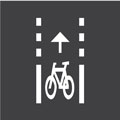
Cars are not permitted to park or drive in a bike lane. However, when making a right turn, they must yield to any bicycle traffic and merge into the bike lane prior to making the turn. A properly designed intersection will always place the straight thru bicycle traffic to the left of a right turn lane. As a bike lane approaches an intersection or bus stop, the white lines may be dashed to indicate a shared space between thru bicyclists and turning motorists.
Bicyclists are not required to ride in the bike lane in Minnesota. Some of the reasons a bicyclist would not ride in the bike lane include that they may be in the “door zone” of parked cars, or they may be blocked by parked cars, debris, or snow and ice. Whenever a bicyclist enters or exits a bike lane, they should be sure to look behind them, signal, and yield to vehicles already in adjacent travel lanes.
Green Bike Lanes
Green bike lanes are pavement markings often used to highlight locations where motorists merge across or turn across a bike lane. To draw attention and increase safety at these locations, bike lanes are colored green to alert motorists that they must yield to thru bicyclists.
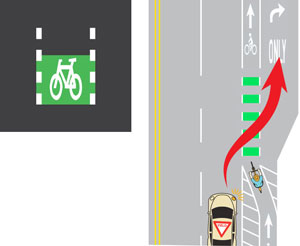
Advisory Bike Lanes
An advisory bike lane is similar to a regular bike lane, but is used on low volume streets that are narrow. They are marked with a solid white line on the right (next to parked cars) and a dotted line to the left. These markings give bicyclists a space to ride, but are also available to motorists if space is needed to pass oncoming traffic. So that motor vehicle drivers can safely meet an oncoming motorist, they are allowed to merge into the bike lane when it is an advisory bike lane. Because of this bicyclists should be more prepared for a motorist to enter the advisory bike lane than they would a typical bike lane. The three foot passing law still applies.
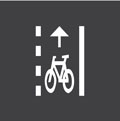
Buffered Bike Lane
A buffered bike lane is similar to a regular bike lane, but also includes a marked buffer between the bike lane and adjacent travel lanes. The purpose of a buffered bike lane is to provide extra elbow room for bicyclists and increase safety. The buffer is placed between the bike lane and travel lane. The buffer may be marked with white chevrons to indicate that no vehicles are allowed to travel in the buffered area.
A buffered bike lane is restricted to bicycle traffic, except in instances when motorists need to turn, enter, or leave the roadway. Whenever motorists must cross a bike lane to prepare for a turn, they must yield if a bicyclist is approaching and let them pass. Like all bike lanes, bicyclists should not ride the wrong way in a buffered bike lane, and they should signal and yield to vehicles already in adjacent travel lanes when they enter or exit a buffered bike lane.
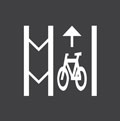
Protected Bikeway
(AKA cycletracks and separated bike lanes)
A protected bikeway is an exclusive area for bicyclists that is physically separated from motor vehicle traffic. Protected bikeways may be one-way or two-way and will be marked appropriately. Protected bikeways may be located within street corridors and separated from traffic lanes by parked cars, curbs, medians, bollards or flexible traffic posts, planters, or other vertical features. This design provides a space within the public right of way for bicyclists and provides additional comfort and separation from motor vehicles lanes.
Where protected bikeways are present, it is extremely important for motorists and bicyclists to be cautious at intersections. Motorists should watch for and expect bicycle traffic in front of them and behind them in protected bikeways and yield when appropriate. As bicyclists in a protected bikeway approach an intersection, they should use caution and assume turning or merging vehicles do not see them due to potential obstructions and their position in the public right of way. Bicyclists using protected bikeways with parked cars between the protected bikeway and the motor vehicle lanes should watch for passenger car doors and pedestrians crossing the bike lane.
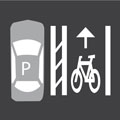
Shared Lane Markings
Shared lane markings or “sharrows” (derived from “shared” and “arrows”) are pavement markings used to mark a designated bike route. Placed in the travel lane, they encourage bicyclists to ride in a safe position outside of the door zone (where driver’s side doors of parked cars open). There are regular shared lane markings and green shared lane markings, they both mean the same thing. Motor vehicles are permitted to drive in travel lanes where shared lane markings are present. Bicyclists may be traveling in the same lane so motorists must travel behind them until it is safe to pass (they must give the bicyclist at least three feet).
Shared lane markings include a bicycle symbol and a double chevron indicating the direction of travel. They do not designate any part of the roadway as either exclusive to motorists or bicyclists. Rather, the symbols highlight the fact that the travel lane is shared.
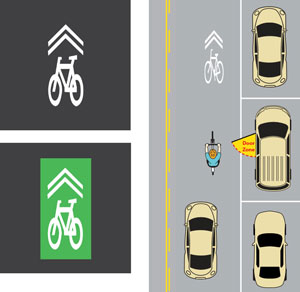
Bike Boulevard
A bike boulevard is a lower-volume, lower-speed street that has been optimized for bike traffic. The purpose of a bike boulevard is to provide bicyclists, especially those who are not comfortable riding on busy streets, a safer and more relaxing place to ride. While many residential streets are already favorable to most bicyclists, a bike boulevard goes the extra step to provide safe crossings at major streets and encourage motorists to travel at slow speeds, while reducing the frequency of stop signs.
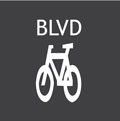
This environment is created through a variety of traffic calming and design elements such as speed humps, traffic circles, curb extensions, medians, and traffic signals. Many of the changes, especially the intersection treatments, improve safety for pedestrians and motorists, too. Bike boulevards are designated with pavement markings that include a large bicycle symbol with the text “BLVD.”
Bike Box
A bike box is a type of advanced stop bar that is used at some signalized intersections. The bike box includes two elements, 1) an advanced stop line for motorists to wait behind, and 2) a marked spaced for bicyclists to wait in. When the traffic signal is red, motorists must wait behind the bike box and behind the stop line. Bicyclists are allowed to ride to the front of the traffic queue into the bike box and wait for a green signal. When the traffic signal turns green, motorists must yield to bicyclists before proceeding or making a turn.
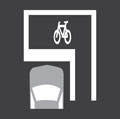
The purpose of a bike box is to allow bicyclists to wait at the front of traffic queues so they are more visible to motorists. This is to improve the safety of bicyclists at intersections.
Bike-Related Road Signs
While motorists are always required to share the road with bicyclists, sometimes there are signs reminding them to do so. For a time, “Share the Road” signs were popular across the state. Recently, however, traffic engineers have started moving away from them for signs with more direct language, such as “Bikes May Use Full Lane.” Their intention is to encourage motorists to avoid crowding cyclists and give them a full three feet. Sometimes there are just yellow diamond-shaped signs (often on sharrows or bike boulevards) that complement the paint on the road to remind motorists bicyclists will be present.
Shoulders & Rumble Strips
Shoulders run parallel to the roadway travel lanes and are designed for the accommodation of stopped vehicles and for emergency use. Bicyclists may legally ride on shoulders, though they are not required to. While shoulders are often the safest place to ride, especially on roads with high speeds or traffic volumes, it is important to note that shoulders may not be as well maintained as the lanes of travel or may be too narrow for safe riding.
Some shoulders incorporate rumble strips, which are a countermeasure for mitigating run-off-the-road crashes. Rumble strips can be hazardous for bicycles. Use caution when entering or exiting the shoulder around rumble strips. Shoulders with rumble strips often have gaps allowing bicyclists to maneuver in and out of the travel lane.
Bicyclists should yield to traffic in adjacent travel lanes when navigating intersections from shoulders.

Roundabouts
Bicyclists can use roundabouts either as a pedestrian or in the same manner as a motorized vehicle. When using them similar to a motorist, bicyclists should center themselves in the travel lane (“take the lane”) in order to make themselves more visible to motorists and to prevent unsafe passing.
